1999 HONDA CIVIC COUPE fuel cap
[x] Cancel search: fuel capPage 1 of 269

1999 Civic Coupe Online Reference Owner's Manual
Use these links (and links throughout this manual) to navigate through this reference.
For a printed owner's manual, click on authorized manuals or go to www.helminc.com.
Contents
Introduction........................................................................\
............................................................................. i
A Few Words About Safety ........................................................................\
.................................................. ii
Your Vehicle at a Glance ........................................................................\
....................................................... 2
Driver and Passenger Safety ........................................................................\
............................................... 5
Pr op
er use and care of your vehicle's seat belts, and Supplemental Restraint System.
Instruments and Controls........................................................................\
...................................................51
Instrument panel in
dicator and gauge, and how to use dashboard and steering column controls.
Comfort and Convenience Features........................................................................\
.................................87
How to op
erate the climate control system, the audio system, and other convenience features.
Before Driving ........................................................................\
.....................................................................123
What gasoli n
e to u
se, how to break-in your new vehicle, and how to load luggage and other cargo.
Driving........................................................................\
...................................................................................135
The proper way t o
start the engine, shift the tr ansmission, and park, plus towing a trailer.
Maintenance........................................................................\
.........................................................................157
T h
e Ma
intenance Schedule shows you when you need to take your vehicle to the dealer.
Appearance Care........................................................................\
.................................................................213
T i
ps on cl
eaning and protecting your vehicle. Things to look for if your car ever needs body repairs.
Taking Care of the Unexpected........................................................................\
.......................................219
This section covers sever
a
l problems motorists someti mes experience, and how to handle them.
Technical Information........................................................................\
.......................................................243
ID numbers, dimens ions, capacities, and techn
ical information.
Warranty and Customer Relations (U.S. and Canada)......................................................................257
A summary of th
e warr
anties covering your new Honda, and how to contact us.
Authorized Manuals (U.S. only)........................................................................\
.......................................263
How t o
order
manuals and other technical literature.
Index ........................................................................\
......................................................................................... I
Servic e Inf
ormation Summary
A summary of informa
tion you need when you pull up to the fuel pump.
Owner's Identification
Page 125 of 269
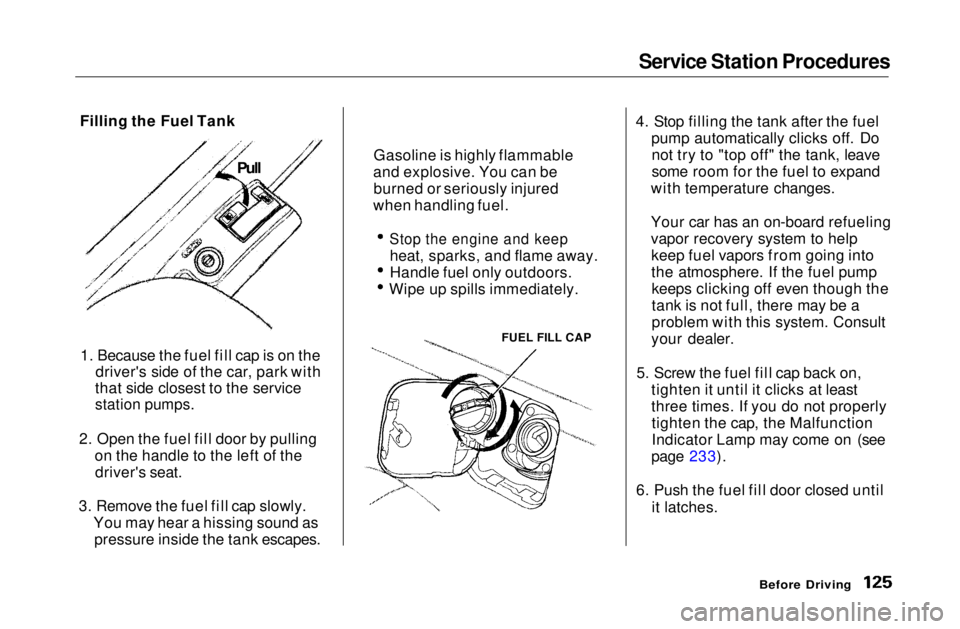
Service Station Procedures
Filling the Fuel Tank
1. Because the fuel fill cap is on the driver's side of the car, park with
that side closest to the service
station pumps.
2. Open the fuel fill door by pulling on the handle to the left of thedriver's seat.
3. Remove the fuel fill cap slowly. You may hear a hissing sound aspressure inside the tank escapes. 4. Stop filling the tank after the fuel
pump automatically clicks off. Donot try to "top off" the tank, leave
some room for the fuel to expand
with temperature changes.
Your car has an on-board refueling
vapor recovery system to help keep fuel vapors from going into
the atmosphere. If the fuel pumpkeeps clicking off even though the
tank is not full, there may be a
problem with this system. Consult
your dealer.
5. Screw the fuel fill cap back on, tighten it until it clicks at least
three times. If you do not properlytighten the cap, the Malfunction
Indicator Lamp may come on (see
page 233).
6. Push the fuel fill door closed until it latches.
Before Driving
FUEL FILL CAP
Gasoline is highly flammable
and explosive. You can be burned or seriously injured
when handling fuel.
Stop the engine and keep
heat, sparks, and flame away.
Handle fuel only outdoors. Wipe up spills immediately.
PullMain Menu Table of Contents s t
Page 170 of 269
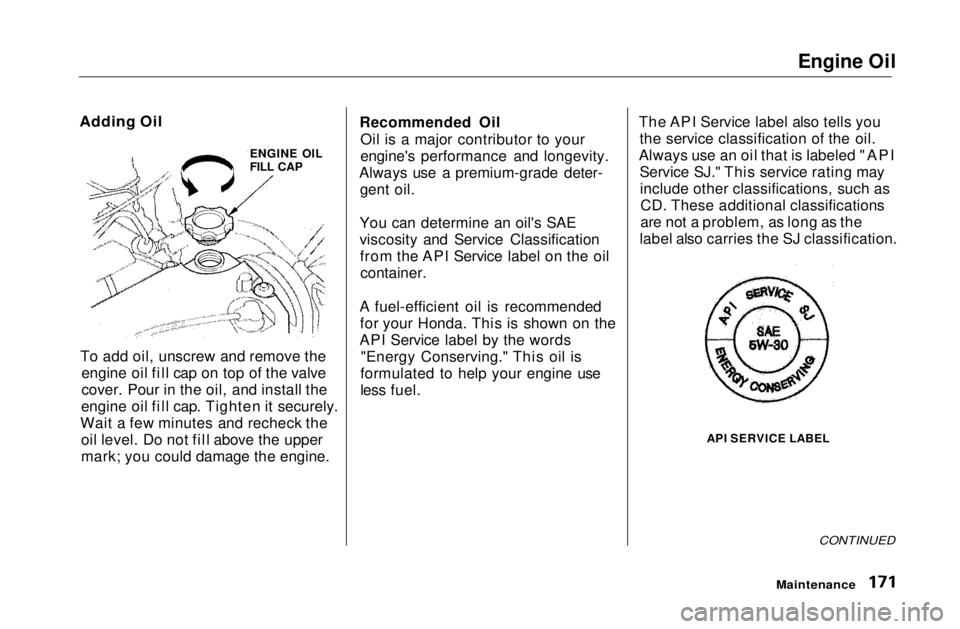
Engine Oil
Adding Oil
To add oil, unscrew and remove the engine oil fill cap on top of the valve
cover. Pour in the oil, and install the
engine oil fill cap. Tighten it securely.
Wait a few minutes and recheck the oil level. Do not fill above the upper
mark; you could damage the engine. Recommended Oil
Oil is a major contributor to your
engine's performance and longevity.
Always use a premium-grade deter- gent oil.
You can determine an oil's SAE
viscosity and Service Classification from the API Service label on the oilcontainer.
A fuel-efficient oil is recommended for your Honda. This is shown on the
API Service label by the words "Energy Conserving." This oil is
formulated to help your engine use
less fuel. The API Service label also tells you
the service classification of the oil.
Always use an oil that is labeled "API Service SJ." This service rating mayinclude other classifications, such asCD. These additional classifications
are not a problem, as long as the
label also carries the SJ classification.
API SERVICE LABEL
CONTINUED
Maintenance
ENGINE OIL
FILL CAPMain Menu Table of Contents s t
Page 179 of 269
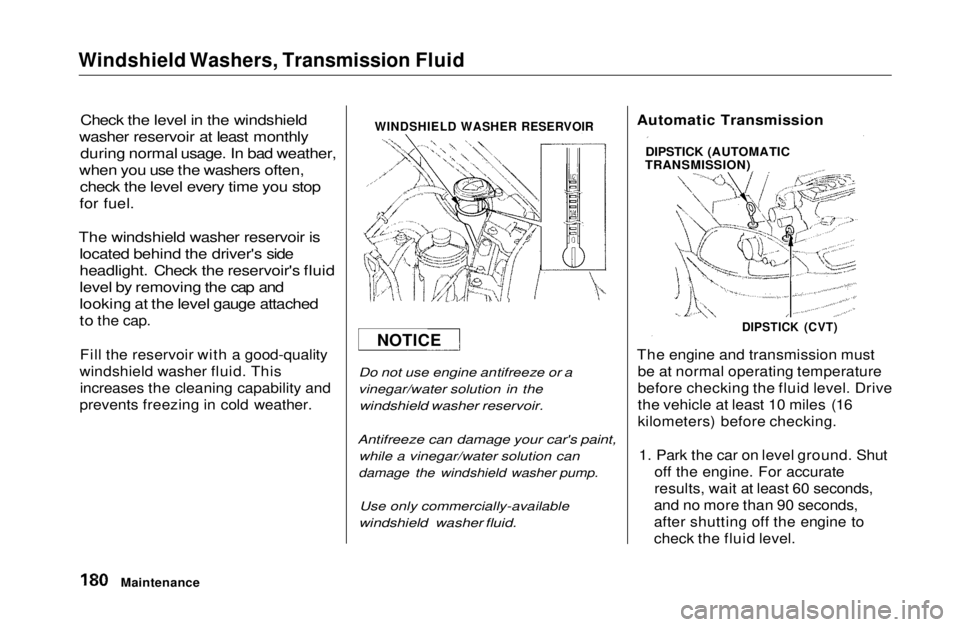
Windshield Washers, Transmission Fluid
Check the level in the windshield
washer reservoir at least monthly during normal usage. In bad weather,
when you use the washers often, check the level every time you stop
for fuel.
The windshield washer reservoir is located behind the driver's side
headlight. Check the reservoir's fluid
level by removing the cap and
looking at the level gauge attached
to
the cap.
Fill the reservoir with a good-quality
windshield washer fluid. This increases the cleaning capability and
prevents freezing in cold weather.
WINDSHIELD WASHER RESERVOIR
Do not use engine antifreeze or a
vinegar/water solution in the
windshield washer reservoir.
Antifreeze can damage your car's paint,
while a vinegar/water solution can
damage the windshield washer pump.
Use only commercially-available
windshield washer fluid.
The engine and transmission must
be at normal operating temperature
before checking the fluid level. Drive
the vehicle at least 10 miles (16
kilometers) before checking.
1. Park the car on level ground. Shut off the engine. For accurate
results, wait at least 60 seconds,
and no more than 90 seconds,
after shutting off the engine to
check the fluid level.
Maintenance
NOTICE
Automatic Transmission
DIPSTICK (AUTOMATIC
TRANSMISSION)
DIPSTICK (CVT)Main Menu Table of Contents s t
Page 232 of 269
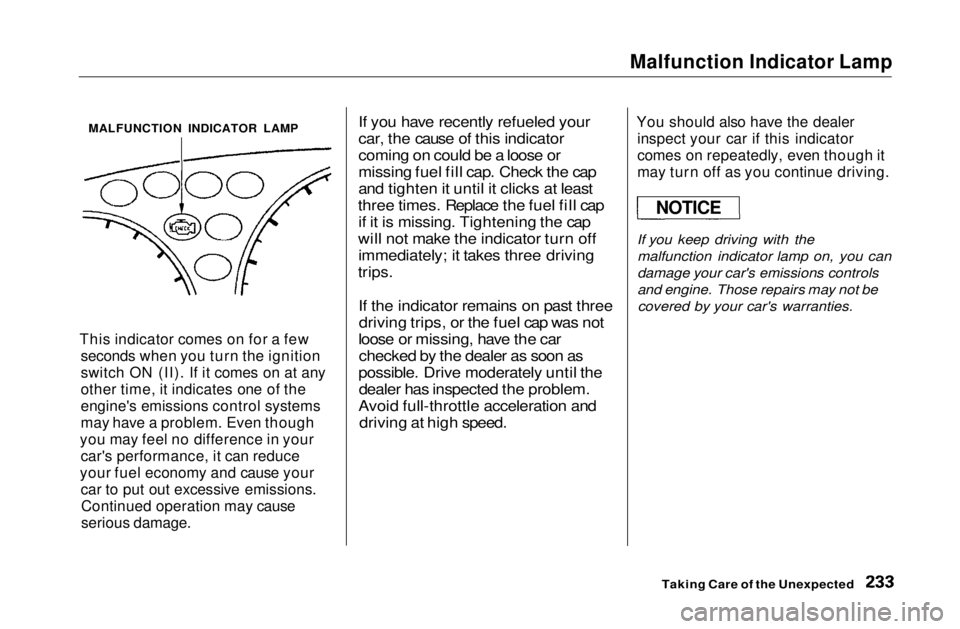
Malfunction Indicator Lamp
This indicator comes on for a few seconds when you turn the ignition
switch ON (II). If it comes on at any
other time, it indicates one of the
engine's emissions control systems
may have a problem. Even though
you may feel no difference in your car's performance, it can reduce
your fuel economy and cause your car to put out excessive emissions.Continued operation may cause
serious damage.
If you have recently refueled your
car, the cause of this indicator
coming on could be a loose or
missing fuel fill cap. Check the cap
and tighten it until it clicks at least
three times. Replace the fuel fill cap if it is missing. Tightening the cap
will not make the indicator turn off immediately; it takes three driving
trips.
If the indicator remains on past threedriving trips, or the fuel cap was not
loose or missing, have the car checked by the dealer as soon as
possible. Drive moderately until the dealer has inspected the problem.
Avoid full-throttle acceleration and driving at high speed.
You should also have the dealer
inspect your car if this indicator
comes on repeatedly, even though it
may turn off as you continue driving.
If you keep driving with the malfunction indicator lamp on, you can
damage your car's emissions controls
and engine. Those repairs may not becovered by your car's warranties.
Taking Care of the Unexpected
MALFUNCTION INDICATOR LAMP
NOTICEMain Menu Table of Contents s t
Page 242 of 269

Technical Information
The diagrams in this section give you the dimensions and capacities of
your Honda, and the locations of the identification numbers. The expla-
nations of several electronic and
mechanical systems on your Honda
are for the more technically-oriented
owner. Identification Numbers................. 244
Specifications................................. 246
Tire Information............................ 249 Tire Size Designation................ 249
Wheel Size Designation............ 249
Tire Speed Ratings.................... 249
Tire Pressure Adjustment For High Speed Driving............... 250
DOT Tire Quality Grading....... 250
Treadwear.............................. 250
Traction.................................. 251Temperature.......................... 251
Oxygenated Fuels.......................... 252
Driving in Foreign Countries....... 253 Emissions Controls........................ 254
The Clean Air Act...................... 254Crankcase Emissions Control System..................................... 254
Evaporative Emissions Control System..................................... 254
Onboard Refueling Vapor Recovery................................. 254
Exhaust Emissions Controls.... 255 PGM-FI System..................... 255
Ignition Timing ControlSystem................................. 255
Exhaust Gas Recirculation (EGR) System.................... 255
Three Way Catalytic Converter............................ 255
Replacement Parts..................... 255
Three Way Catalytic Converter... 256
Technical InformationMain Menu s t
Page 253 of 269
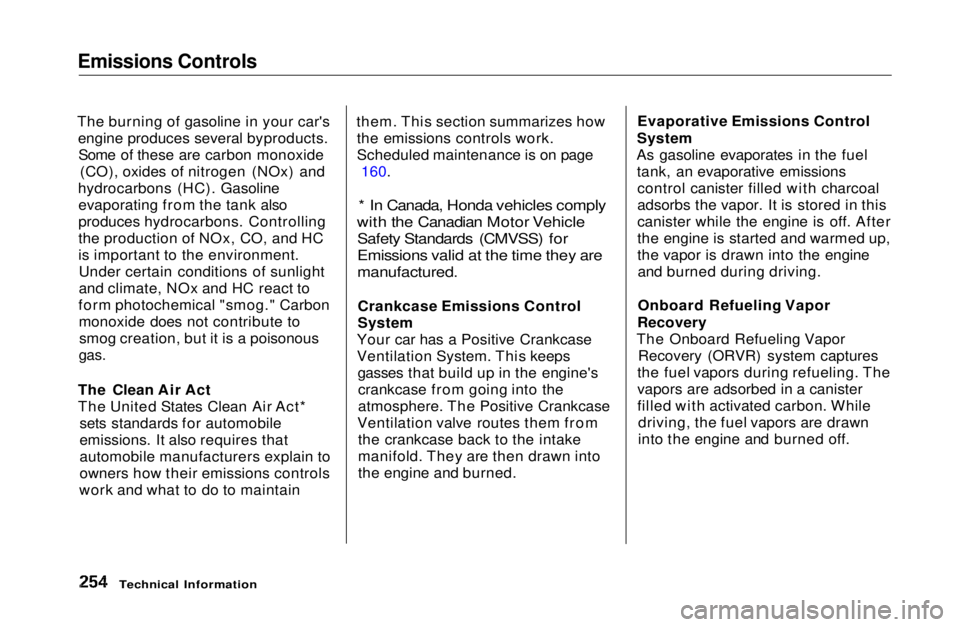
Emissions Controls
The burning of gasoline in your car's engine produces several byproducts.Some of these are carbon monoxide (CO), oxides of nitrogen (NOx) and
hydrocarbons (HC). Gasoline evaporating from the tank also
produces hydrocarbons. Controlling
the production of NOx, CO, and HC
is important to the environment.Under certain conditions of sunlight
and climate, NOx and HC react to
form photochemical "smog." Carbon monoxide does not contribute tosmog creation, but it is a poisonous
gas.
The Clean Air Act
The United States Clean Air Act* sets standards for automobile
emissions. It also requires that
automobile manufacturers explain to
owners how their emissions controls
work and what to do to maintain them. This section summarizes how
the emissions controls work.
Scheduled maintenance is on page 160.
* In Canada, Honda vehicles comply
with the Canadian Motor Vehicle Safety Standards (CMVSS) for
Emissions valid at the time they are
manufactured.
Crankcase Emissions Control
System
Your car has a Positive Crankcase
Ventilation System. This keeps gasses that build up in the engine'scrankcase from going into the
atmosphere. The Positive Crankcase
Ventilation valve routes them from the crankcase back to the intake
manifold. They are then drawn into
the engine and burned. Evaporative Emissions Control
System
As gasoline evaporates in the fuel tank, an evaporative emissionscontrol canister filled with charcoal
adsorbs the vapor. It is stored in this
canister while the engine is off. After
the engine is started and warmed up,
the vapor is drawn into the engineand burned during driving.
Onboard Refueling Vapor
Recovery
The Onboard Refueling Vapor Recovery (ORVR) system captures
the fuel vapors during refueling. The
vapors are adsorbed in a canister
filled with activated carbon. While driving, the fuel vapors are drawn
into the engine and burned off.
Technical InformationMain Menu Table of Contents s t
Page 263 of 269

Index
Ethanol in Gasoline ....................... 252
Evaporative Emissions Controls.. 254
Exhaust Fumes................................ 49
Expectant Mothers, Use of Seat Belts by......................................... 19
Exterior, Cleaning the................... 214
Fabric, Cleaning............................. 216
Fan, Interior...................................... 88
Features, Comfort and Convenience................................. 87
Filling the Fuel Tank..................... 125
Filters Air................................................ 185
Oil................................................ 173
5-speed Manual Transmission
Checking Fluid Level................ 182
Shifting the................................. 138
Flashers, Hazard Warning.............. 64
Flat Tire, Changing a.................... 221
Fluids Automatic Transmission........... 180Brake........................................... 183Clutch.......................................... 183 Manual Transmission............... 182
Power Steering........................... 184
Windshield Washer................... 180
FM Stereo Radio Reception.................................... 120
Folding Rear Seat............................ 78
Foreign Countries, Driving in...... 253
Four-way Flashers........................... 64
Front End, Towing by Emergency Wrecker................. 241
Fuel.................................................. 124
Fill Door and Cap....................... 125Gauge............................................ 58
Octane Requirement................. 124
Oxygenated................................ 252
Reserve Indicator......................... 58
Tank, Filling the......................... 125
Fuses, Checking the...................... 236
Gas Mileage, Improving................ 129
Gasohol........................................... 252
Gasoline.......................................... 124
Fuel Reserve Indicator................ 58
Gauge............................................ 58
Octane Requirement................. 124
Tank, Filling the......................... 125
Gas Station Procedures................. 125
Gauges
Engine Coolant Temperature .... 58
Fuel................................................58
Gearshift Lever Positions
Automatic Transmission........... 140
5-speed Manual
Transmission.......................... 138
Glass Cleaning............................... 217
Glove Box......................................... 83
Halogen Headlight Bulbs.............. 204
Hazard Warning Flashers............... 64
Headlights
Daytime Running Lights............. 61
High Beam Indicator................... 55
High Beams, Turning on............ 61
Low Beams, Turning on............. 61
Reminder Beeper......................... 61
Replacing Halogen Bulbs ......... 204
Turning on.................................... 61
Head Restraints............................... 77Main Menu s t